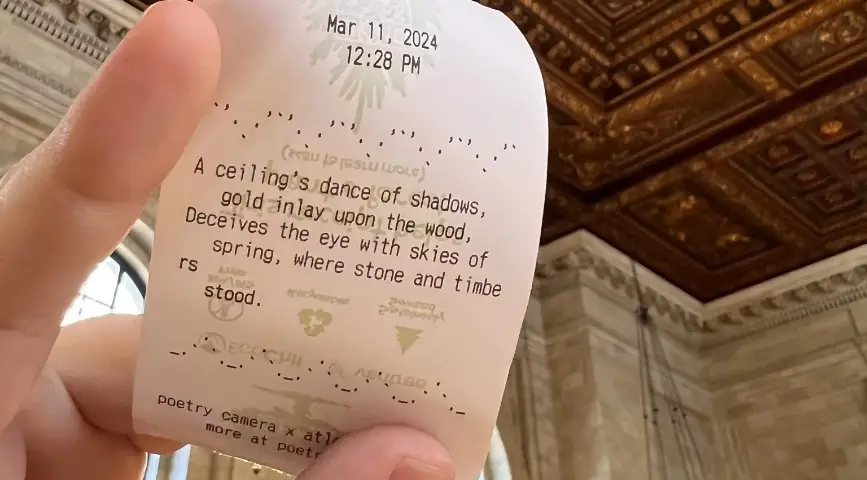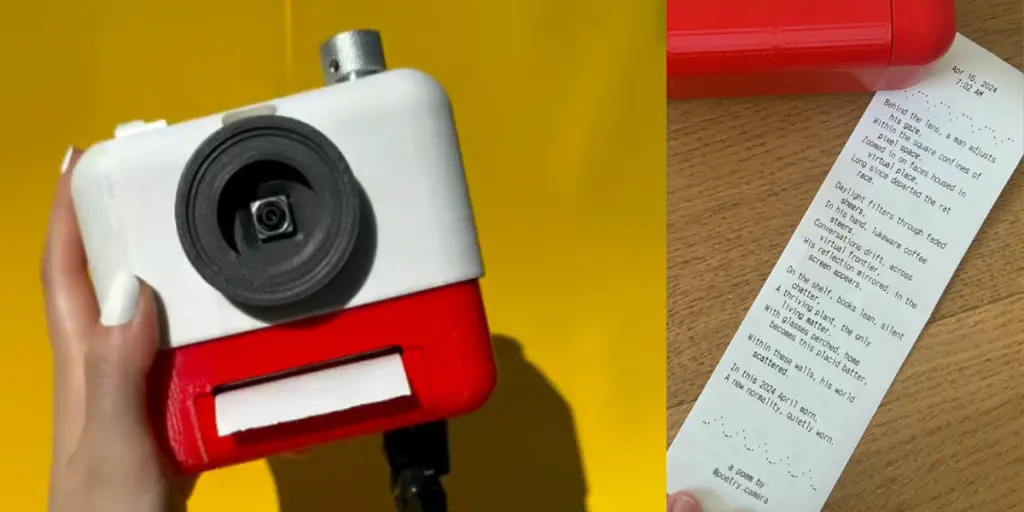What is Poetry Camera? Turn Photo into Poetry

The Poetry Camera is a groundbreaking device that epitomizes the convergence of technology and the arts. This innovative camera takes ordinary images and transforms them into evocative poetic expressions, utilizing advanced AI algorithms. By delving into the nuances of how the Poetry Camera works, its origins, key features, and future prospects, this article aims to explore the unique capabilities and transformative potential of this fascinating technology.
Explore the Poetry Camera, an innovative tool that turns photographs into poetry through AI, illustrating the seamless integration of art and technology.
Table of Contents
What is Poetry Camera?

The Poetry Camera is an inventive tool that transforms visual images into poetic compositions. Developed by Kelin Carolyn Zhang and Ryan Mather, this camera diverges from conventional photography by not merely capturing photos but interpreting them poetically. This device embodies a unique blend of art and technology, using a Raspberry Pi and OpenAI’s GPT-4 model to analyze images and generate corresponding poems. The camera offers various poetry styles, including haikus, sonnets, and free verse, allowing users to express creativity in multiple poetic forms.
Key Features of Poetry Camera

The Poetry Camera is a groundbreaking device that leverages advanced technology to create a fusion of visual imagery and poetic expression. This unique camera offers several key features that set it apart from any traditional photographic equipment.
Versatile Poetry Formats
The Poetry Camera introduces a versatile approach to poetic creation, enabling users to choose from a variety of poetic formats.
- Selection of poetic styles: Users can select from styles like haikus, sonnets, and free verse.
- Customizability: The format can be tailored to reflect the mood or theme of the captured image.
Advanced AI Integration
At its core, the Poetry Camera integrates sophisticated AI to analyze and interpret images into poetry.
- Use of OpenAI’s GPT-4: Employs advanced AI to generate coherent and contextually relevant poems.
- Deep learning algorithms: Analyzes complex visual elements and emotions.
- Real-time processing: Offers immediate poetic translations of visual scenes.
User-Friendly Interface
Designed with the user in mind, the Poetry Camera boasts an interface that is accessible and easy to navigate.
- Intuitive design: Easy for beginners and professionals alike.
- On-device editing: Users can modify or refine the generated poems directly on the device.
- Digital storage: Poems are saved digitally for easy access and sharing.
Differences between Poetry Camera and traditional camera
The Poetry Camera redefines the concept of capturing moments by transforming visual images into poetic narratives, setting it distinctly apart from traditional cameras.
- Output: Traditional cameras capture and store images as visual files, whereas the Poetry Camera generates a poetic representation of the image.
- Technology Utilization: Unlike traditional cameras that focus primarily on image clarity and quality, the Poetry Camera uses AI to extract deeper meaning from the images.
- User Interaction: The process of using the Poetry Camera involves interaction not just with the device but with the art it creates, offering a more engaging experience.
How does Poetry Camera combine AI technology with art?
The Poetry Camera is a stellar example of how artificial intelligence can enhance artistic creativity. By leveraging AI technology, this camera interprets and transforms photographs into poetic verses, offering a unique blend of visual and literary art.
- AI-Powered Interpretation: The camera employs AI to analyze visual details like color, shape, and emotion in images, extracting elements that inform its poetic creations.
- Creative Expression: It then uses this information to compose poems that reflect the essence and mood of the original scene, effectively turning a visual snapshot into a literary artwork.
- Customization Options: Users can influence the poetic style, choosing from formats such as haiku, sonnet, or free verse, allowing for a personalized artistic output.
- Interactive Artistic Experience: This fusion of AI and art not only automates the creation of poetry but also invites users to engage directly with the artistic process, making art more interactive and accessible.
How does Poetry Camera work?

The Poetry Camera is an innovative device that transforms visual images into poetic expressions, merging technology with art through a streamlined process.
Image Capture
The operation begins with the camera capturing high-resolution images. This initial capture is crucial as it provides the detailed visual data needed for analysis and poetic interpretation.
Visual Data Analysis
Once the image is captured, the built-in AI analyzes it, identifying colors, patterns, and emotional cues. This step is essential for translating the visual information into a context that can be expressed poetically.
Poetic Generation
Using the analyzed data, the Poetry Camera’s AI, powered by OpenAI’s GPT-4, composes a poem that captures the essence of the image. Users can customize the style of the poem, adding a personal touch to the generated poetry.
Output and Sharing
Finally, the poem is printed directly from the camera and also saved digitally. This allows for immediate physical sharing and online distribution, making it easy to share the poetic creations with others.
Where to get Poetry Camera?
Currently, the Poetry Camera is not available for mass market purchase as it began as a passion project by its creators, Kelin Carolyn Zhang and Ryan Mather. However, due to growing interest from the public, there are plans to make it more accessible in the future. Interested individuals should keep an eye on the official Poetry Camera website and its associated social media channels for announcements regarding availability. For those eager to experiment with the technology, the developers have made the project open source. Detailed instructions for building your own Poetry Camera are available on the project’s website, providing a DIY alternative for technology enthusiasts and creative minds.
Origin of Poetry Camera
Poetry Camera was conceived by Kelin Carolyn Zhang and Ryan Mather as a unique blend of their passions for technology and poetry. Initially inspired by the capabilities of AI in playing Dungeons & Dragons, the idea evolved into creating a device that could translate the visual world into poetic expressions. The project began as an experiment with various AI models and eventually led to the development of a camera that uses OpenAI’s GPT technology to create poems from images, merging artistic vision with technological innovation.
Future Developments of Poetry Camera
The future of the Poetry Camera looks promising with ongoing enhancements to its AI capabilities and potential commercial availability. The developers are focused on refining the AI’s interpretative accuracy and expanding the range of poetic styles available. There is also consideration of integrating more advanced sensors to improve image analysis, which could lead to even more nuanced and complex poetic outputs. Additionally, as interest grows, the creators are exploring partnerships and funding opportunities to scale the project, potentially introducing the Poetry Camera into educational and artistic institutions as a tool for learning and creative exploration.
Resources and Support for Poetry Camera
Conclusion
The Poetry Camera is more than just a technological innovation; it is a new medium of artistic expression that bridges the gap between visual art and poetry. Through its unique ability to transform images into poems, it offers a fresh perspective on the interaction between technology and human creativity. As the camera continues to develop and become more accessible, it holds the potential to inspire a new generation of artists and technologists, forever changing how we perceive and interpret the world around us.

